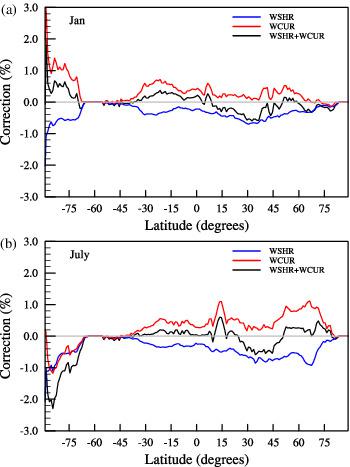当前位置:
X-MOL 学术
›
Q. J. R. Meteorol. Soc.
›
论文详情
Our official English website, www.x-mol.net, welcomes your feedback! (Note: you will need to create a separate account there.)
Impacts of wind profile shear and curvature on the parameterized orographic gravity wave stress in the Weather Research and Forecasting model
Quarterly Journal of the Royal Meteorological Society ( IF 8.9 ) Pub Date : 2020-05-17 , DOI: 10.1002/qj.3828 Xin Xu 1 , Miguel A. C. Teixeira 2 , Ming Xue 1, 3 , Yixiong Lu 4 , Jianping Tang 1
Quarterly Journal of the Royal Meteorological Society ( IF 8.9 ) Pub Date : 2020-05-17 , DOI: 10.1002/qj.3828 Xin Xu 1 , Miguel A. C. Teixeira 2 , Ming Xue 1, 3 , Yixiong Lu 4 , Jianping Tang 1
Affiliation

|
The parameterization of orographic gravity wave drag (OGWD) in the Weather Research and Forecasting model is extended by including the second‐order Wentzel–Kramers–Brillouin (WKB) corrections to the surface wave momentum flux (SWMF) caused by wind profile shear (WSHR) and curvature (WCUR) effects. Simulations of the atmospheric circulation are performed to study the behaviour and impact of the WKB corrections. In January, the SWMF is weakened in the Northern Hemisphere (NH) midlatitudes by the WSHR term, while the WCUR acts to enhance the SWMF over Antarctica. In July, the WSHR corrections are similar to those in January, whereas the WCUR term produces corrections of opposite sign in the high latitudes of each hemisphere. The latter is attributed to the increase of near‐surface winds in the cold season which reverses the low‐level wind profile curvature. The seasonal reversal of the WCUR term contradicts previous findings obtained from offline evaluation using reanalysis datasets. This may be due to the different OGWD parameterization schemes used, or it may suggest a sensitivity to the height at which the wind profile effects are evaluated. Changes in the SWMF can affect the vertical distribution of parameterized OGWD. In January, the OGWD in the NH midlatitudes is decreased in the lower troposphere but increased in the upper troposphere. This is because a reduced SWMF inhibits wave breaking in the lower troposphere. Therefore, more wave momentum flux (WMF) is transported to the upper troposphere which enhances wave breaking there. The increased upper‐tropospheric wave breaking in turn decreases the WMF propagating into the stratosphere where the OGWD is reduced. In July, the reduction of SWMF over Antarctica is more notable than in the NH midlatitudes in January. Consequently, the OGWD is weakened in the upper troposphere over Antarctica.
中文翻译:

风廓线切变和曲率对天气研究和预报模型中参数化地形重力波应力的影响
通过将二阶Wentzel–Kramers–Brillouin(WKB)校正包括对风廓线切变(WSHR)引起的表面波动量通量(SWMF)进行校正,扩展了Weather Research and Forecasting模型中的地形重力波阻力(OGWD)的参数化)和曲率(WCUR)效果。进行大气环流模拟以研究WKB校正的行为和影响。一月,WSHR术语将北半球(NH)中纬度的SWMF减弱,而WCUR则在南极上空增强SWMF。在7月,WSHR的校正与1月的校正相似,而WCUR术语在每个半球的高纬度产生相反符号的校正。后者归因于寒冷季节近地表风的增加,从而扭转了低层风廓线的曲率。WCUR术语的季节性逆转与使用重新分析数据集从离线评估中获得的先前发现相矛盾。这可能是由于使用了不同的OGWD参数化方案,或者可能暗示了对评估风廓线影响的高度的敏感性。SWMF的变化会影响参数化OGWD的垂直分布。在1月,北半球对流层中纬度的OGWD下降,而对流层上层则增加。这是因为减小的SWMF会抑制低层对流层中的波破裂。因此,更多的波动量通量(WMF)被传输到对流层上层,从而增强了对流层的破碎能力。对流层上升波的增加反过来又减少了传播到平流层的WMF,在平流层中OGWD减小了。在7月,南极中纬度地区的SWMF降幅要比1月在NH中纬度地区明显。因此,南极对流层上方的对流层中的OGWD减弱了。
更新日期:2020-05-17
中文翻译:

风廓线切变和曲率对天气研究和预报模型中参数化地形重力波应力的影响
通过将二阶Wentzel–Kramers–Brillouin(WKB)校正包括对风廓线切变(WSHR)引起的表面波动量通量(SWMF)进行校正,扩展了Weather Research and Forecasting模型中的地形重力波阻力(OGWD)的参数化)和曲率(WCUR)效果。进行大气环流模拟以研究WKB校正的行为和影响。一月,WSHR术语将北半球(NH)中纬度的SWMF减弱,而WCUR则在南极上空增强SWMF。在7月,WSHR的校正与1月的校正相似,而WCUR术语在每个半球的高纬度产生相反符号的校正。后者归因于寒冷季节近地表风的增加,从而扭转了低层风廓线的曲率。WCUR术语的季节性逆转与使用重新分析数据集从离线评估中获得的先前发现相矛盾。这可能是由于使用了不同的OGWD参数化方案,或者可能暗示了对评估风廓线影响的高度的敏感性。SWMF的变化会影响参数化OGWD的垂直分布。在1月,北半球对流层中纬度的OGWD下降,而对流层上层则增加。这是因为减小的SWMF会抑制低层对流层中的波破裂。因此,更多的波动量通量(WMF)被传输到对流层上层,从而增强了对流层的破碎能力。对流层上升波的增加反过来又减少了传播到平流层的WMF,在平流层中OGWD减小了。在7月,南极中纬度地区的SWMF降幅要比1月在NH中纬度地区明显。因此,南极对流层上方的对流层中的OGWD减弱了。



























 京公网安备 11010802027423号
京公网安备 11010802027423号